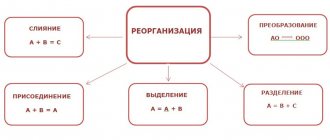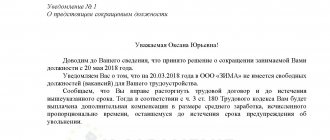Probably everyone knows what reorganization of a legal entity is. In government institutions it is carried out even more often than in commercial organizations. As a rule, reorganization is associated with a change in the organizational and legal form (when, for example, a unitary institution becomes a state institution), a change in the owner of the institution’s property, the merger of several organizations into one, etc. This process affects not only organizational and financial relations, but also labor ones. What is reorganization? In what forms can it occur? What responsibilities does an employer have towards employees? In what cases are they subject to dismissal? You will find answers to these and other questions in this article.
Reorganization and its forms
The concept of reorganization is absent in the legislation. However, as some experts define it, this is the termination or other change in the legal status of a legal entity, entailing relations of succession of legal entities, as a result of which the simultaneous creation of one or more new legal entities and the termination of one or more previous legal entities occur.
According to Art. 57 and 58 of the Civil Code of the Russian Federation, reorganization of a legal entity is carried out in the following forms:
— merger, when a new legal entity is formed from several legal entities that cease their activities;
- merger, when one legal entity is joined by another legal entity that ceases its activities, and in the end one remains;
— division, when one legal entity is divided into several legal entities;
- separation, when another legal entity is separated from one legal entity, while both continue to conduct their activities;
- transformation, when a legal entity of one type is transformed into a legal entity of another type, while the first one ceases its activities (change in legal form).
The reorganization of federal institutions is discussed in a separate regulatory legal act - Decree of the Government of the Russian Federation dated July 26, 2010 N 539 “On approval of the Procedure for the creation, reorganization, change of type and liquidation of federal state institutions, as well as approval of the charters of federal state institutions and amendments to them.” According to this resolution, the reorganization of a federal institution can be carried out in the form of a merger, annexation, division or separation.
The decision on the reorganization of a federal institution in the form of division, spin-off, merger (if the legal entity resulting from the merger is a federal government institution) or annexation (in the case of the merger of a federal budgetary or autonomous institution with a government institution) is made by the Government of the Russian Federation.
The decision on reorganization in the form of merger or accession, with the exception of these cases, is made by the federal executive body exercising the functions and powers of developing state policy and legal regulation in the established field of activity.
By virtue of Art. 57 of the Civil Code of the Russian Federation, reorganization of a legal entity can be carried out by decision of its founders (participants) or a body of the legal entity authorized to do so by the constituent documents.
A legal entity is considered reorganized, with the exception of cases of reorganization in the form of merger, from the moment of state registration of newly emerged legal entities. When a legal entity is reorganized in the form of the merger of another legal entity with it, the first of them is considered reorganized from the moment an entry on the termination of the activities of the merged legal entity is made in the Unified State Register of Legal Entities.
Employer's liability
If the labor rights of employees of a given enterprise have been violated, they can always send a corresponding complaint against their employer to the authorities that control these issues, for example, the prosecutor’s office or the state labor inspectorate.
As a rule, the employer faces administrative liability for such actions. This issue is regulated by Article 5 of the Labor Code.
There are the following types of punishments:
- a fine in the amount of one thousand to fifty thousand rubles;
- suspension of the organization’s activities for up to three months;
- material compensation to an employee from a legal entity in the amount of earnings that were not received by him as a result of a violation of rights.
It is necessary to summarize. Reorganization is the legal modernization of a company through merger, accession, spin-off, etc.
The procedure itself does not become a reason for the dismissal of employees during reorganization, which is prescribed in the Labor Code of the Russian Federation. An employee can resign only on his own initiative.
He must know about the reorganization two months before it occurs, and only after that the employee makes a decision: to stay or leave the workplace.
The reduction is necessarily accompanied by compensation.
Labor Relations
Article 75 of the Labor Code of the Russian Federation talks about labor relations during reorganization. Moreover, in addition to the reorganization, a change in the owner of the organization’s property and a change in its jurisdiction are separately indicated.
Let’s consider what is meant by a change in the owner of an organization’s property and a change in its jurisdiction.
A change in the owner of the organization’s property in accordance with clause 32 of the Resolution of the Plenum of the Armed Forces of the Russian Federation dated March 17, 2004 N 2 “On the application by the courts of the Russian Federation of the Labor Code of the Russian Federation” is a transition (transfer) of ownership of the organization’s property from one person to another person or other persons, in particular:
- during the privatization of state or municipal property, that is, during the alienation of property owned by the Russian Federation, constituent entities of the Russian Federation, municipalities, into the ownership of individuals and (or) legal entities (Article 1 of the Federal Law of December 21, 2001 N 178-FZ “On privatization of state and municipal property”, Article 217 of the Civil Code of the Russian Federation);
- when converting property owned by an organization into state ownership (Article 235 of the Civil Code of the Russian Federation);
— when transferring state enterprises to municipal ownership and vice versa;
- when transferring a federal state enterprise to the ownership of a constituent entity of the Russian Federation and vice versa.
A change in the ownership of the property of a state institution is, in essence, a reorganization in the form of transformation.
As for changing the jurisdiction (subordination) of an organization, this means transferring the organization from the jurisdiction (subordination) of one body to the jurisdiction (subordination) of another body.
So, Art. 75 of the Labor Code of the Russian Federation establishes that when there is a change in the owner of the organization’s property, a change in the jurisdiction (subordination) of the organization or its reorganization (merger, annexation, division, spin-off, transformation) or a change in the type of state or municipal institution, employment contracts with employees are not terminated. An exception is the possibility of terminating employment contracts with the head of the organization, his deputies and the chief accountant when the owner of the organization’s property changes. The new owner may terminate employment contracts with these persons no later than three months from the date on which he acquired ownership rights.
Note. The ownership of the enterprise passes to the buyer from the moment of state registration of this right (Article 564 of the Civil Code of the Russian Federation).
Upon termination of employment contracts with these persons, the new owner is obliged to pay them compensation in the amount of not less than three average monthly earnings of these workers (Article 181 of the Labor Code of the Russian Federation). The basis for termination of the employment contract in such cases will be clause 4, part 1, art. 81 of the Labor Code of the Russian Federation - change of owner of the organization’s property.
Article 75 of the Labor Code of the Russian Federation also establishes the right of an employee to refuse to continue working in connection with a change in the owner of the organization’s property, a change in the jurisdiction of the organization, its reorganization, or a change in the type of state or municipal institution. The employment contract in these cases is terminated in accordance with clause 6, part 1, art. 77 of the Labor Code of the Russian Federation (an employee’s refusal to continue working in connection with a change in the owner of the organization’s property, a change in the jurisdiction (subordination) of the organization or its reorganization, a change in the type of state or municipal institution).
Definition of concepts
The reasons for a reduction in headcount or staff can be many circumstances, for example, a decrease in the profitability and financial stability of an economic entity or reorientation of production.
If in many cases the problem can be solved without laying off people, then in the case of reorganization and especially liquidation of the company, layoffs are inevitable .
Staff reduction means the company abandons certain positions. For example, a reduction in the position of a legal adviser is accompanied by the dismissal of all specialists occupying this vacancy.
Downsizing is a reduction in the number of employees performing the same duties. For example, reducing the number of legal advisers from 4 to 2.
We wrote about the difference between downsizing and downsizing here.
What does a change in company structure mean?
Reorganization means the termination of a company's activities with the transfer of rights to another legal entity or several individuals. As a result of the reorganization, one or more enterprises may be liquidated and at the same time one or more economic units may be created.
Important! Reorganization can be carried out in different forms (accession, merger, division, separation, transformation). At the same time, the new owners can take either the path of downsizing or staff reduction.
What does closure of a company mean?
Liquidation involves the complete completion of the work of a legal entity without transferring rights to other persons. Liquidation can occur either voluntarily or forcibly (at the insistence of the judiciary).
Based on the essence of the word “reduction” and, in particular, the terms “staff reduction” and “reduction in headcount”, during liquidation it is not reductions that are carried out, but layoffs.
This is confirmed by the norms of the Labor Code of the Russian Federation, which distinguishes between the concepts of “reduction” and “dismissal due to liquidation”. For example, this can be observed in the second part of Article 180 of the Labor Code of the Russian Federation. However, in both cases the same procedure for providing guarantees, notifications , etc. is applied, with some exceptions.
Paperwork
As already mentioned, labor relations with employees in the event of a change in the owner of the organization’s property (with the exception of persons established by Part 1 of Article 75 of the Labor Code of the Russian Federation), reorganization, or change of jurisdiction are preserved. That is, employment contracts remain the same. But additional agreements must be concluded with them.
However, first, the employer should notify employees of the upcoming reorganization, change of ownership of property or change of jurisdiction, as well as the right of employees to terminate their employment relationship in connection with this.
Such an obligation is not established by law, unless simultaneously with the reorganization the terms of the employment contract are changed or there is a reduction in the number of employees or staff. However, in order for employees to exercise the right to terminate their employment relationship established in Art. 75 of the Labor Code of the Russian Federation, this still needs to be done. The question here is: when should such notice be given? Since this issue is not regulated by the Labor Code, other provisions should be followed. Thus, in the case when the reorganization is accompanied by a change in the employee’s working conditions (place of work, structural unit, conditions of payment, position, etc.), notification is sent two months before the upcoming changes by virtue of Art. 74 Labor Code of the Russian Federation.
It should be borne in mind that all employees, including those on vacation or sick leave, should be notified.
So, while the employee was on her next vacation, the municipality was reorganized into the regional state educational institution “Special (correctional) orphanage No. 2 for orphans and children without parental care with disabilities.” Due to the reorganization, the number of children increased; as a result, the work schedule of this employee was subject to change. The employee was not notified about such a change before she returned from her next vacation in the prescribed manner (namely two months in advance).
The employee refused to work under the new regime, for which she was disciplined and then fired.
However, the court reinstated her in her previous position with payment of wages for the period of forced absence and compensation for moral damage, and the dismissal under such circumstances was declared illegal (Cassation ruling of the Khabarovsk Regional Court dated April 27, 2011 in case No. 33-2747/2011).
If no changes in working conditions are planned, employees must be notified as soon as possible from the moment of state registration of changes during reorganization or entry into force of a regulatory legal act when jurisdiction changes. In this case, it is not necessary to notify each employee against signature, but this information can be conveyed to employees orally or by posting on a notice board, etc. In this case, it should be noted that employees have the right to terminate their employment relationship by submitting an appropriate application.
Employees who submit such a statement will have their employment contract terminated. The following entry is made in the work book: “The employment contract is terminated due to the employee’s refusal to continue working in connection with the reorganization of the organization, paragraph 6 of part one of Article 77 of the Labor Code of the Russian Federation.”
And on what basis should an employee be dismissed if he does not agree to continue working due to a change in the terms of the employment contract: according to clause 6 or 7 of Part 1 of Art. 77 of the Labor Code of the Russian Federation (an employee’s refusal to continue working due to a change in the terms of the employment contract determined by the parties)?
Since there are no clarifications on this issue, we believe that it would be simpler and more expedient to dismiss under clause 6, part 1, art. 77 Labor Code of the Russian Federation. In any case, the employee can always resign of his own free will.
Note! Dismissal of an employee under clause 6, part 1, art. 77 of the Labor Code of the Russian Federation should be drawn up after the completion of the reorganization, that is, from the moment the entry is made in the state register.
Additional agreements to employment contracts must be concluded with employees who continue to work. The agreements indicate all changes, including changes in the terms of the employment contract, that occurred as a result of the reorganization. In addition, it is necessary to make an entry in the work book.
Since the Instructions for filling out work books, approved by Resolution of the Ministry of Labor of the Russian Federation dated October 10, 2003 N 69, do not regulate the procedure for making such entries in the work book, it is assumed that the entry in this case should be similar to the entry on changing the name of the organization (clause 3.2 of the said instructions) , for example: “The municipal unitary enterprise “Fakel” was reorganized in the form of transformation into a closed joint-stock company “Svetoch” from July 15, 2014.”
What problems might there be?
One of the main problems that arise when dismissing, for example, department employees in connection with the reorganization of an enterprise, is the lack of clear regulatory regulation of this issue. The Labor Code of the Russian Federation does not stipulate how this procedure should be implemented.
In addition, employers may face the following difficulties:
- The impossibility of dismissing individual employees - as mentioned above, there are categories of workers who are under special protection of the law. We are talking about pregnant women, workers on maternity leave, on maternity leave, etc. These personnel cannot be fired.
- Violation of the requirement to notify all workers about upcoming changes - written notice should be sent to absolutely all personnel, including those who are on vacation or sick leave. In addition, it is important to do this in a timely manner (2 months before the reorganization).
- Lack of signature of the dismissed person in the order to terminate the employment contract - this should also be monitored, otherwise the employer may have problems.
Reduction of staff during reorganization
Quite often, when an institution is reorganized (for example, during a merger, division, spin-off), there is a reduction in the number of employees or staff.
In Letter of Rostrud dated 02/05/2007 N 276-6-0 on this matter, it is noted that the reorganization may be accompanied by an actual reduction in the number of employees or staff of the organization. In this case, as a rule, the staffing table changes, new structural units and positions may be introduced into it, and individual positions may be excluded from it.
In this case, as officials point out, we can talk not about the priority right to hire, but about the priority right to remain at work when the number of employees or staff is reduced. Preferential right to remain at work is given to employees with higher labor productivity and qualifications.
With equal labor productivity and qualifications, preference in remaining at work is given to families with two or more dependents (disabled family members who are fully supported by the employee or receive assistance from him, which is for them a permanent and main source of livelihood), persons in whose family there are no other employees with independent earnings, employees who received a work injury or occupational disease while working for a given employer, disabled people of the Great Patriotic War and disabled people from military operations in defense of the Fatherland, employees who improve their skills in the direction of the employer without interruption from work.
Note! If the employee’s position is retained in the new staffing table, there are no grounds for dismissal due to staff reduction.
According to Art. 180 of the Labor Code of the Russian Federation about the upcoming dismissal due to a reduction in the number of employees or staff, employees are warned by the employer personally against their signature at least two months before the dismissal. With the written consent of the employee, the employment contract with him can be terminated before the expiration of the specified period.
Thus, two months before the reorganization, which is accompanied by a reduction in staff, employees must be notified of this. In addition, the employer is obliged to offer the laid-off employee another available job (vacant position) in accordance with Part 3 of Art. 81 Labor Code of the Russian Federation. You can do all this in one notification.
It should be noted that if a reduction in the number of employees or staff is carried out in connection with a change in the owner of the organization’s property, then by virtue of Part 4 of Art. 75 of the Labor Code of the Russian Federation, such a reduction is allowed only after state registration of ownership by the new owner. That is, only after registration of ownership rights the new owner begins the reduction procedure.
If an employee refuses to work in a new vacant position or there is no such position in the organization, the employment contract with him is terminated under clause 2 of part 1 of Art. 81 of the Labor Code of the Russian Federation, and the dismissed employee is paid severance pay in the amount of average monthly earnings. He also retains his average monthly earnings for the period of employment, but not more than two months from the date of dismissal (including severance pay), and in exceptional cases, the average monthly earnings are retained for the third month from the date of dismissal by decision of the employment service authority, provided that that within two weeks after dismissal, the employee applied to this body and was not employed by it (Article 178 of the Labor Code of the Russian Federation).
If the employment contract is terminated earlier than two months, the employee is paid additional compensation in the amount of his average earnings, calculated in proportion to the time remaining before the expiration of the notice of dismissal.
Please note that if an employee is subject to dismissal due to a reduction in staff or number of employees, then replacing this basis for dismissal with dismissal under clause 6, part 1, art. 77 of the Labor Code of the Russian Federation or at one’s own request may be declared illegal by the court, since it deprives the employee of the right to receive guarantees established by the Labor Code in the event of dismissal due to staff reduction.
Guarantees and benefits for employees
Labor legislation provides for a number of guarantees and compensations for persons who have been laid off.
Thus, Article 180 of the Labor Code of the Russian Federation provides:
- In the event of a layoff, the employer is obliged to offer the employee who has been laid off another position available in the organization.
- The employee must be warned in advance about his planned dismissal.
- An employer may terminate an employment contract with an employee before the date of layoff if the latter has found another job.
- The employer is obliged to make all payments established by law to the laid-off employee.
Main compensation payments include:
- wages;
- payment of compensation for vacation that was not used;
- bonuses;
- benefits while looking for a job;
- other payments specified in the internal documents of the organization.
Separately about vacation
Since employers often make mistakes when providing annual paid leave in the event of reorganization, this issue deserves special attention.
Let us recall that the right to use vacation for the first year of work arises for an employee after six months of continuous work with a given employer. By agreement of the parties, paid leave may be provided to the employee before the expiration of six months (Article 122 of the Labor Code of the Russian Federation).
The order of provision of paid vacations is determined annually in accordance with the vacation schedule approved by the employer, taking into account the opinion of the elected body of the primary trade union organization no later than two weeks before the start of the calendar year.
Note! The vacation schedule is mandatory for both the employer and the employee (Article 123 of the Labor Code of the Russian Federation).
As mentioned above, during the reorganization of the institution (including when the owner of the property changes), the employment relationship continues; accordingly, the employee retains the right to leave and the length of service for granting leave is not interrupted. And vacation schedules drawn up before the reorganization remain valid. Therefore, employees must go on vacation in accordance with the current vacation schedule.
Question. For the period of work from 01/05/2014 to 01/04/2015, according to the vacation schedule, the employee must be granted leave of 40 calendar days from 09/30/2014 to 11/10/2014. As of November 1, 2015, the institution is planning to reorganize. Before the reorganization, can an employer provide vacation not in the amount of 40 days, but in proportion to the time worked by the employee before the reorganization?
Since the employment relationship with employees continues, leave must be granted according to the leave schedule. In this case, by agreement between the employee and the employer, annual paid leave can be divided into parts. Moreover, at least one part of this vacation must be at least 14 calendar days (Article 125 of the Labor Code of the Russian Federation).
Article 124 of the Labor Code of the Russian Federation establishes cases of transferring vacation to another period. In exceptional cases, when granting an employee leave in the current working year may adversely affect the normal course of work of the organization, it is allowed, with the consent of the employee, to transfer the leave to the next working year. In this case, the leave must be used no later than 12 months after the end of the working year for which it is granted.
Thus, if the employee agrees to divide the vacation into parts and transfer the second part of the vacation to another time (in this case, after reorganization) or to the next working year, this can be done. In this case, the employee must be asked to submit an application requesting the division and transfer of vacation, and changes must also be made to the vacation schedule.
If the employee does not agree, the employer is obliged to provide him with leave according to the schedule in full, regardless of whether it falls during the period of reorganization.
If the employee exercised his right to terminate the employment contract in connection with the reorganization under clause 6 of Part 1 of Art. 77 of the Labor Code of the Russian Federation, on the day of dismissal he is paid monetary compensation for all unused vacations.
The same rule applies when the reorganization is accompanied by a reduction in the number of employees or staff. That is, if an employee quits due to a reduction in the number of employees or staff, and according to the vacation schedule, he is given vacation until the expiration of two months before the termination of the employment contract, or he partially goes beyond this period, then he must be granted vacation.
In addition, according to Art. 127 of the Labor Code of the Russian Federation, upon a written application from an employee, unused vacations may be granted to him with subsequent dismissal (except for cases of dismissal for guilty actions). In this case, the day of dismissal is considered the last day of vacation.
Also note that when paying compensation for unused vacation upon dismissal of an employee in accordance with the Rules on regular and additional vacations, approved by the People's Commissariat of Labor of the USSR on April 30, 1930 N 169, in the event of liquidation of an enterprise or institution or its individual parts, reduction of staff or work, and Also, during reorganization or temporary suspension of work, an employee who has worked from 5.5 to 11 months receives full compensation, that is, for all annual and additional paid leave due to him.
Documentation accompanying the reduction
Any type of reform of a legal entity, be that as it may, must be confirmed by the necessary papers. A typical set of papers includes:
- order on the reorganization of a legal entity - this contains amended information about the institution, a description of the form of reform, the day of making entries in individual cards and work books of employees, as well as information about when employees should receive notice of layoffs.
This paper represents the basis for continuing staff reductions and their immediate dismissal;
- notification that the employer has changed, there has been a layoff, or changes have been made to employment contracts. As a rule, such documents are made in two copies. The employee must put his signature on them, confirming the fact of his familiarization.
The notice includes the following information:
- The day of the upcoming dismissal, as well as its grounds.
- A list of alternative positions that could be filled by a particular person being dismissed.
- All the necessary signatures affixed by the authorities.
This document is intended to become a fact confirming compliance with the law when reorganizing the company.
Important! According to the law, the employer is responsible for promptly notifying people of further layoffs. This procedure must be carried out no later than sixty days before the reduction, or no later than ninety days if a lot of people are leaving.
- dismissal order. It must include the following information:
- All required details.
- Link to the number and day of conclusion of the contract to be terminated.
- The day of leaving work.
- Full name of the employee, his number in the report card and position held.
- Reason for dismissal.
What is this change?
Reorganization in the form of affiliation is a complex legal procedure that results in the merger of two or more organizations. In this process, some legal entities can be liquidated and new ones created.
At the same time, the subjects who receive certain rights and responsibilities change.
The legal successor receives all rights to property and monetary resources.
The reorganization is regulated by several legislative acts of the Russian Federation, including laws on LLCs, JSCs, the Civil Code, and the Labor Code.
It is noteworthy that only firms with the same organizational and legal form can participate in the merger.
As a rule, reorganization inevitably affects the interests of the company's employees. Once this process is completed, their terms of employment and employment contract may change.
Where does the reduction occur during reorganization in the form of affiliation? In an acquired institution, often in a company that merges with another organization, there is a need to reduce the number or staff of employees.
This is not a rare practice when a newly created institution provides far fewer vacancies than there are workers themselves. Thus, part of the personnel of the acquired enterprise is subject to layoffs.
Important . No form of company reorganization is considered a valid reason for terminating employees. Dismissal is possible only on the personal initiative of an employee who is not satisfied with the new conditions. This norm is enshrined in
Article 75 of the Labor Code of the Russian Federation
.
If the employment relationship with the employee continues after the reorganization, he automatically becomes an employee of the new successor company - there is no need to dismiss such a person with documentation and then re-employ him.
Compensation
The employee decided to leave the workplace due to the reorganization of a particular enterprise after it had occurred.
He draws up a letter of resignation of his own free will, indicating in it the day of termination of the employment contract.
Compensation provided for staff reduction and reorganization:
- earnings for the period worked;
- for vacation days that were not used;
- bonuses included in the employment agreement in accordance with the period worked;
- if the staff was reduced due to reorganization, wages during the period of employment (up to three months);
- other compensation in accordance with the employment contract.
Employees who decide not to continue working for the reorganized company are entitled to the following payments:
- wages accrued for the period actually worked;
- compensation for vacation days unused by the employee;
- other payments provided for by the regulations of the enterprise.
Important! When renouncing an employment relationship due to reorganization, the citizen is not entitled to accrual of severance pay.
But if an employee is laid off, then in addition to the specified compensation, he can count on receiving an additional amount upon dismissal. The one-time payment corresponds to average earnings. A similar amount is transferred to the laid-off employee for another 2 months, but only if there is no new place of work.
Dismissal of employees as a result of enterprise reorganization requires compliance with a number of rules established by law. If the rules governing the process of termination of the contract are ignored, the procedure is subject to challenge in court with its further recognition as invalid. In this case, the employer may fall under administrative sanctions, and the employee may request payment of compensation for moral damage with further reinstatement to his former position.
Payments upon liquidation of an organization and reduction, what is the difference?
- Salary until the last working day.
- Compensation for unused vacation.
- Compensation severance pay.
If the collective agreement does not stipulate its size, then it should be determined by mutual agreement.
- notify the employment service;
- send notification to trade union organizations;
- are communicated personally to each employee.
But, such a right comes into force only upon final liquidation. That is, if the company completely ceases to exist.
The employer must inform the trade union body about the upcoming dismissal at least three months before the procedure.
In this article we will talk about how not to violate legal norms when laying off employees of a liquidated enterprise. Content
- 1 Features of abbreviation
- 2 Dismissal procedure
- 3 The work of a “personnel officer”
- 4 Employee notification
- 5 Preparation of documents
Employee certification
Part 3 of Art. 31 of Law No. 79-FZ establishes that within two months of warning, a government agency may conduct an extraordinary certification of civil servants.
Based on its results, employees who have a preferential right to fill a civil service position may be given other civil service positions to fill, including in another government body. The next certification of a civil servant is carried out once every three years.
Certification is carried out in accordance with Art. 48 of Law No. 79-FZ. Certification of a civil servant is carried out in order to determine his suitability for the position being filled.
According to Part 5 of Art. 48 of Law No. 79-FZ, an extraordinary certification of a civil servant may be carried out earlier than the specified period after a decision is made in the prescribed manner:








